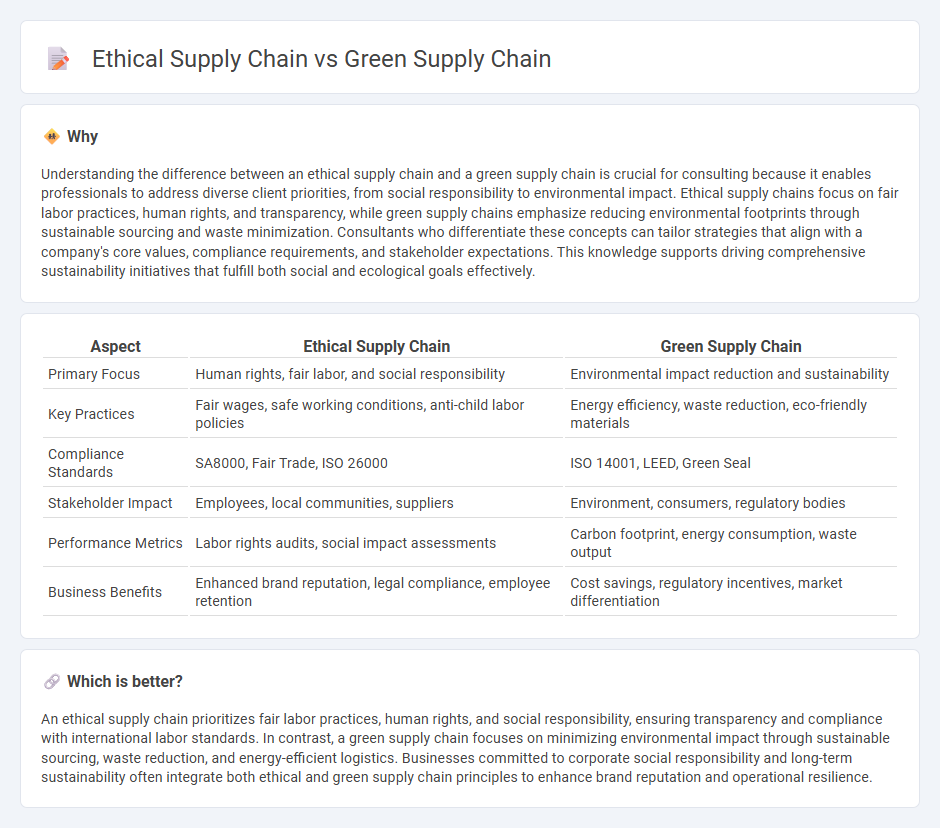
Ethical supply chains prioritize human rights, fair labor practices, and transparent sourcing to ensure social responsibility across all production stages. Green supply chains focus on minimizing environmental impact by incorporating sustainable materials, reducing emissions, and optimizing resource efficiency. Explore how integrating ethical and green supply chain strategies can enhance corporate sustainability performance.
Why it is important
Understanding the difference between an ethical supply chain and a green supply chain is crucial for consulting because it enables professionals to address diverse client priorities, from social responsibility to environmental impact. Ethical supply chains focus on fair labor practices, human rights, and transparency, while green supply chains emphasize reducing environmental footprints through sustainable sourcing and waste minimization. Consultants who differentiate these concepts can tailor strategies that align with a company's core values, compliance requirements, and stakeholder expectations. This knowledge supports driving comprehensive sustainability initiatives that fulfill both social and ecological goals effectively.
Comparison Table
| Aspect | Ethical Supply Chain | Green Supply Chain |
|---|---|---|
| Primary Focus | Human rights, fair labor, and social responsibility | Environmental impact reduction and sustainability |
| Key Practices | Fair wages, safe working conditions, anti-child labor policies | Energy efficiency, waste reduction, eco-friendly materials |
| Compliance Standards | SA8000, Fair Trade, ISO 26000 | ISO 14001, LEED, Green Seal |
| Stakeholder Impact | Employees, local communities, suppliers | Environment, consumers, regulatory bodies |
| Performance Metrics | Labor rights audits, social impact assessments | Carbon footprint, energy consumption, waste output |
| Business Benefits | Enhanced brand reputation, legal compliance, employee retention | Cost savings, regulatory incentives, market differentiation |
Which is better?
An ethical supply chain prioritizes fair labor practices, human rights, and social responsibility, ensuring transparency and compliance with international labor standards. In contrast, a green supply chain focuses on minimizing environmental impact through sustainable sourcing, waste reduction, and energy-efficient logistics. Businesses committed to corporate social responsibility and long-term sustainability often integrate both ethical and green supply chain principles to enhance brand reputation and operational resilience.
Connection
Ethical supply chains and green supply chains are interconnected through their shared focus on sustainability, transparent sourcing, and minimizing environmental impact. Both approaches emphasize responsible practices that protect human rights, ensure fair labor conditions, and reduce carbon footprints across the supply network. Integrating ethical and green supply chain strategies enhances corporate social responsibility and drives long-term value for businesses and stakeholders.
Key Terms
Environmental Impact
A green supply chain prioritizes minimizing environmental impact through sustainable sourcing, waste reduction, and energy-efficient logistics, directly aiming to reduce carbon footprints and resource consumption. An ethical supply chain encompasses broader concerns, including fair labor practices and social responsibility, but also integrates environmental stewardship to ensure long-term sustainability. Discover more about how these supply chain models drive corporate responsibility and environmental performance.
Fair Labor Practices
Green supply chains emphasize sustainable environmental practices, minimizing carbon footprints, waste, and resource consumption throughout production and distribution. Ethical supply chains prioritize fair labor practices, ensuring worker rights, safe working conditions, fair wages, and no child or forced labor within the supply network. Explore more to understand how integrating both approaches can create responsible and sustainable business operations.
Sustainable Sourcing
Green supply chain emphasizes reducing environmental impact through sustainable sourcing practices such as using renewable materials, minimizing waste, and optimizing energy consumption across the supply network. Ethical supply chain prioritizes responsible sourcing by ensuring fair labor conditions, transparency, and social equity alongside environmental considerations in sustainable sourcing. Explore detailed strategies and benefits of integrating green and ethical principles for sustainable sourcing in your supply chain.
Source and External Links
Understanding Green Supply Chains: A Starting Point for Change - Green supply chains integrate environmentally responsible practices at every stage, including responsible sourcing with certified materials, supplier audits, logistics optimization to reduce emissions, and waste control through circular strategies to minimize environmental harm.
Green Supply Chain Management | EBSCO Research Starters - Green supply chain management (GSCM) focuses on sustainable practices from product design to disposal, involving reverse logistics, carbon footprint reduction, collaborative stakeholder efforts, and addressing both environmental compliance and consumer demand for green products.
What is Green Supply Chain Management? - GEP - GSCM embeds sustainable environmental processes in conventional supply chains applying the 4R1D principle (reduce, reuse, recycle, reclaim, degradable) with innovations like eco-friendly packaging, supplier environmental criteria, and low-emission transport such as electric vehicles to reduce impact on global warming and pollution.
 dowidth.com
dowidth.com